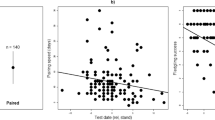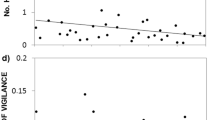Abstract
In avian species whose chicks show facultative siblicide, attacks increase with food deprivation. In species that show obligate siblicide, this causal relationship is not expected, but no test has been made. When we composed artificial pairs of young brown boobies, Sula leucogaster (an obligately siblicidal species), and supplied variable amounts of food to the older nestlings in each pair, food ingestion was related to the most intense form of attack, pushes, which can cause death by expelling the broodmate from the nest. The less food an older nestling ingested, the more time it spent active and the greater its rate and absolute frequency of pushes, and the more often it expelled its nestmate. Hence, deficient food provision to older nestlings could precipitate siblicidal expulsion of broodmates. Younger nestmates were aggressive too, and the more they were pushed and expelled, the more they pecked. Aggression of senior brown-booby broodmates may be flexible and food sensitive in order to optimize the timing of siblicide or to make siblicide weakly facultative.


Similar content being viewed by others
References
Amerson BA, Shelton PC (1976) The natural history of Johnston Atoll, Central Pacific Ocean. Atoll Res Bull 192:213–235
Anderson DJ (1990a) Evolution of obligate siblicide in boobies. I. A test of the insurance-egg hypothesis. Am Nat 135:334–350
Anderson DJ (1990b) Evolution of obligate siblicide in boobies. II. Food limitation and parent-offspring conflict. Evolution 44:2069–2082
Cash KJ, Evans RM (1986) Brood reduction in the american white pelican (Pelecanus erythrorhynchos). Behav Ecol Sociobiol 18:413–418
Clifford LD, Anderson DJ (2001) Experimental demonstration of the insurance value of extra eggs in an obligately siblicidal seabird. Behav Ecol 12:340–347
Cohen Fernández EJ (1988) La reduccion de la nidada en el bobo café (Sula leucogaster nesiotes Heller and Snodgrass 1901). Thesis, Universidad Nacional Autónoma de México
Cook MI, Monaghan P, Burns MD (2000) Effects of short-term hunger and competitive asymmetry on facultative aggression in nestling black guillemots Cepphus grylle. Behav Ecol 11:282–287
Creighton JC, Schnell GD (1996) Proximate control of siblicide in cattle egrets: a test of the food amount hypothesis. Behav Ecol Sociobiol 38:371–377
Dorward EF (1962) Comparative biology of the white booby and brown booby, Sula spp. at Ascension. Ibis 103b:174–220
Drummond H (1993) Have avian parents lost control of offspring aggression? Etología 3:187–198
Drummond H (2001a) A revaluation of the role of food in nestling aggression. Anim Behav 61:1–10
Drummond H (2001b) The control and function of agonism in avian broodmates. In: Slater PJB, Rosenblatt JS, Snowdon CT, Roper TJ (eds) Advances in the study of the behavior. Academic, New York, pp 261–301
Drummond H (2002) Begging versus aggression in avian broodmate competition. In: Wright J, Leonard ML (eds) The evolution of begging: competition, cooperation and communication. Kluwer, Dordrecht, pp 337–360
Drummond H, García-Chavelas C (1989) Food shortage influences sibling aggression in the blue-footed booby. Anim Behav 37:806–819
Drummond H, Rodríguez C, Vallarino A, Valderrábano C, Rogel G, Tobón E (2003) Desperado siblings: uncontrollably aggressive junior chicks. Behav Ecol Sociobiol 53:287–296
Evans RM (1996) Hatching asynchrony and survival of insurance offspring in an obligate brood-reducing species, the american white pelican. Behav Ecol Sociobiol 39:203–209
Evans RM (1997) Parental investment and quality of insurance offspring in an obligate brood-reducing species, the american white pelican. Behav Ecol 8:378–383
Forbes LS (1990) Insurance offspring and the evolution of avian clutch size. J Theor Biol 147:345–359
Forbes LS (1991) Insurance offspring and brood reduction in a variable environment: the costs and benefits of pessimism. Oikos 62:325–332
Forbes LS, Mock DW (1996) Food, information and avian brood reduction. Ecoscience 3:45–53
Forbes LS, Mock DW (1998) Parental optimism and progeny choice: when is screening for offspring quality affordable? J Theor Biol 192:3–14
Forbes LS, Ydenberg RC (1992) Sibling rivalry in a variable environment. Theor Popul Biol 41:335–360
Friesen VL, Anderson DJ (1997) Phylogeny and evolution of the Sulidae (Aves: Pelecaniformes): a test of alternative modes of speciation. Mol Phylogen Evol 7:252–260
Gargett V (1978) Sibling aggression in the black eagle in the Matopos, Rhodesia. Ostrich 49:57–63
Gerhardt RP, Gerhardt DM, Vásquez MA (1997) Siblicide in swallow-tailed kites. Wilson Bull 109:112–120
Golla W, Hofer H, East ML (1999) Within-litter aggression in spotted hyaenas: effect of maternal nursing, sex and age. Anim Behav 58:715–726
Grant PR (1964) The birds of the Tres Marietas Islands, Nayarít, Mexico. Auk 81:514–519
Guerra MC, Drummond H (1995) Reversed sexual size dimorphism and parental care: minimal division of labour in the blue-footed booby. Behaviour 132:479–496
Irons DB (1992) Aspects of foraging behavior and reproductive biology of the black-legged kittiwake. PhD Thesis, University of California, Irvine
Lougheed LW, Anderson DJ (1999) Parent blue-footed boobies suppress siblicidal behavior of offspring. Behav Ecol Sociobiol 45:11–18
Machmer MM, Ydenberg RC (1998) The relative roles of hunger and size asymmetry in sibling aggression between nestling ospreys Pandion haliaetus. Can J Zool 76:181–186
Meyburg BU (1977) Sibling aggression and cross-fostering of eagles. In: Temple SA (ed) Endangered birds. University of Wisconsin Press, Madison, pp 195–200
Mock DW, Parker GA (1997) The evolution of sibling rivalry. Oxford University Press, London
Mock DW, Lamey TC, Williams CF, Ploger BJ (1987) Proximate and ultimate roles of food amount in regulating egret sibling aggression. Ecology 68:1760–1772
Nelson JB (1978) The Sulidae: gannets and boobies. Oxford University Press, London
O'Connor RJ (1978) Brood reduction in birds: selection for fraticide, infanticide, and suicide. Anim Behav 26:79–96
Rebón-Gallardo F (2000) Distribución, abundancia y conservación de la avifauna de las islas Marietas, Nayarit, México. An Inst Biol Univ Nac Auton Mex Ser Zool 71:59–88
Rice WR, Gaines SD (1994) "Heads I win, tails you lose": testing directional alternative hypotheses in ecological and evolutionary research. Trends Ecol Evol 6:235–237
Siegel S, Catellan NJ Jr (1988) Nonparametric statistics for the behavioral sciences, 2nd edn. McGraw-Hill, New York
Simmons R (1988) Offspring quality and the evolution of cainism. Ibis 130:339–357
Smale L, Holekamp KE, Weldele M, Frank LG, Glickman SE (1995) Competition and cooperation between litter-mates in the spotted hyaena, Crocuta crocuta. Anim Behav 50:671–682
Steyn P (1973) Observations on the tawny eagle. Ostrich 44:1–23
Stinson CH (1979) On the selective advantage of fratricide in raptors. Evolution 33:1219–1225
Tershey BR, Breese D, Croll DA (2000) Insurance eggs versus additional eggs: do brown boobies practice obligate siblicide? Auk 117:817–820
Wachter B, Honer OP, East ML, Golla W, Hofer H (2002) Low aggression levels and unbiased sex ratios in a prey-rich environment: no evidence of siblicide in Ngorongoro spotted hyenas. Behav Ecol Sociobiol 52:348–356
Acknowledgements
We are very grateful to Claudia Valderrábano, Fabio Costa, Guadalupe Hernández, Haydeé Peralta, Paula Rodríguez and Adriana Vallarino for dedicated help with fieldwork, to Miguel Rodríguez-Gironés, Bonnie Ploger, Robert Gibson and Doug Mock for comments on the manuscript, to Cristina Rodríguez Juarez for help with organization, logistics and graphics, and to Carmen Pérez for help with analyses and manuscript preparation. Logistical support was generously provided by Justino Niebla, José Luis Menéndez and the crew of the Princesa Vallarta. The experiment and observations were authorized by the Secretaría del Medioambiente y Recursos Naturales (permit number DOO.02.-10491) and carried out in accordance with Mexican law. This research was financed by CONACYT grant 31973 to H.D. and by the U.N.A.M.
Author information
Authors and Affiliations
Corresponding author
Additional information
Communicated by R. Gibson
Rights and permissions
About this article
Cite this article
Osorno, J.L., Drummond, H. Is obligate siblicidal aggression food sensitive?. Behav Ecol Sociobiol 54, 547–554 (2003). https://doi.org/10.1007/s00265-003-0667-3
Received:
Revised:
Accepted:
Published:
Issue Date:
DOI: https://doi.org/10.1007/s00265-003-0667-3




